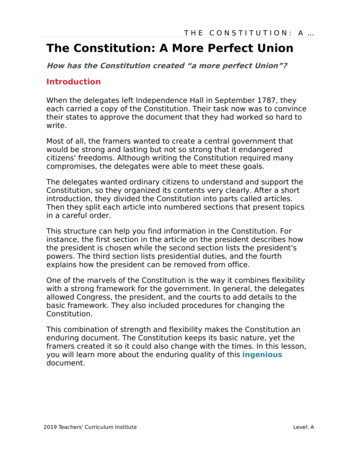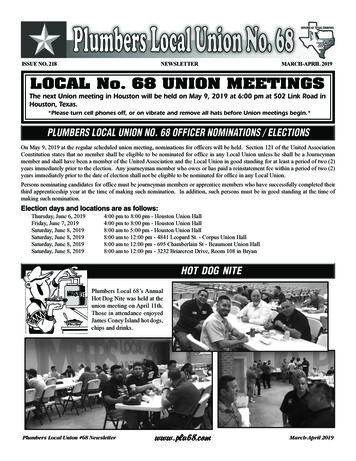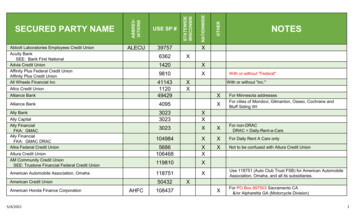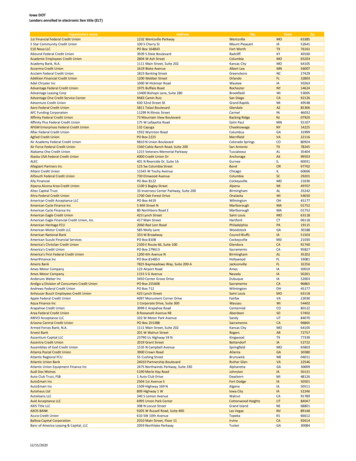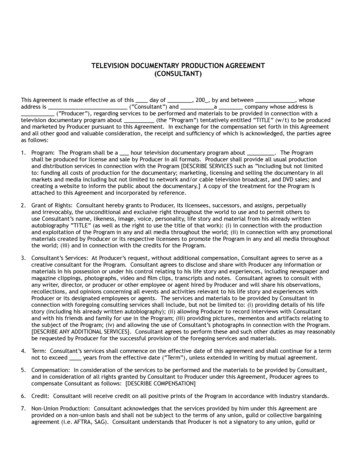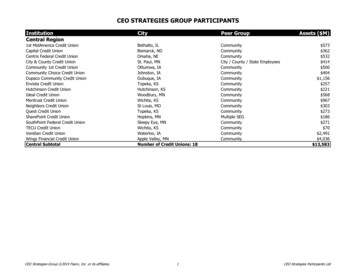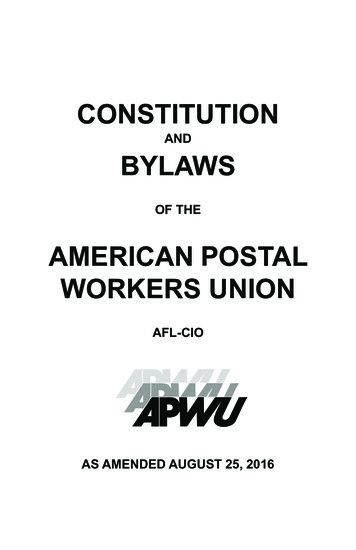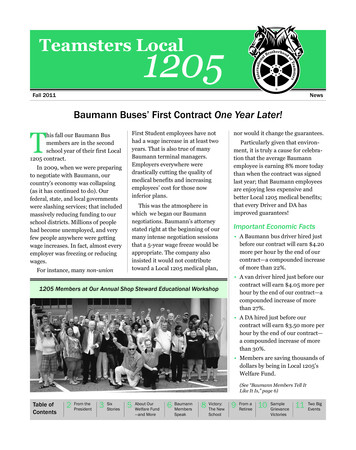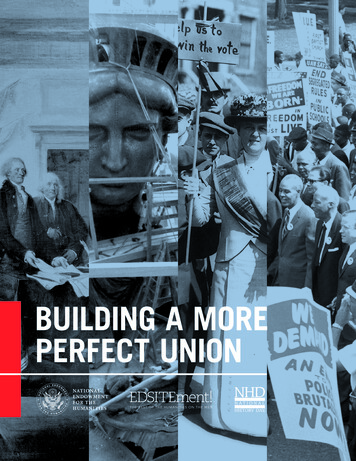
Transcription
BUILDING A MOREPERFECT UNION1
MANAGING EDITOREDITORSLynne M. O’HaraNational History DayLynne M. O’HaraAshley Foley DabbraccioNational Endowment for the HumanitiesJason Harshman, PhDNHD IS ENDORSED BYAmerican Association for State and Local HistoryAmerican Historical AssociationFederation of State Humanities CouncilsLewis and Clark Trail Heritage FoundationNational Association of Secondary School PrincipalsNational Council for History EducationNational Council on Public HistoryOrganization of American HistoriansSociety for American ArchivistsTHIS PUBLICATION IS SPONSORED BYNHD IS ALSO GENEROUSLY SUPPORTED BYPatricia BehringCelie and Tabitha NiehausDiana Davis Spencer FoundationRooker Family Foundation4511 Knox RoadSuite 205College Park, MD 20740Phone: 301-314-9739Fax: 301-314-9767Email: info@nhd.orgWebsite: nhd.orgFront Cover Image Credits (from left to right): 2021 National History Day. May be duplicatedfor educational purposes. Not for resale.ISBN: 978-1-7350104-1-0Back Cover Image Credits:James F. HarrisWorld Education FoundationJohn Trumbull, Declaration of Independence. c.1900-1912. Library of Congress (2016817173).Statue of Liberty copper construction. c. 1800. Musee des Arts et Metiers. Wikimedia Commons.Help us to win the vote. Photograph. 1914. Library of Congress (97500240).Warren K. Leffler. Civil rights march on Wash[ington], D.C. / [WKL]. Photograph. August 28, 1963.Library of Congress (2003688164).Opera Singer Marian Anderson stands in front of the statue of Lincoln Bridgeman Images (EVB2935363).1
TABLE OF CONTENTSWhat is National History Day 3Editors’ Note 4“Toward A More Perfect Union” 5Serena Zabin, Professor of History, Carleton CollegeThe American Revolution in Four Questions: Digging Deeper for Unfamiliar StoriesAdrienne G. Whaley, Director of Education and Community Engagement, Museum of the American Revolution12Lesson Plans2A Voter’s Guide to Post-French and Indian War Policy18Quelling the Whiskey Rebellion: Taking a Stand for Our Future21The Monroe Doctrine: Debating America’s Defense of Independence Abroad24A More Perfect Union: Women and the Abolition Movement28African American Suffragists and the Nineteenth Amendment31Challenging School Segregation: The Fight of Chinese Americans34The Seattle General Strike of 1919: Labor Unions Uniting for Change37The NAACP’s Mission to Forge a More Perfect Union40The Indian Citizenship Act and the Meaning of American Citizenship43Exclusion or Inclusion? The Japanese Struggle to Own Land in California46You’re Invited! A Dinner Party with Heroines of the Civil Rights Movement49The 1968 Indian Civil Rights Act: From Termination to Self-Determination52Rising Tides of U.S. Immigration during the Cold War55The Equal Rights Amendment: Debating a More Perfect Union58The Americans with Disabilities Act: Taking Action For Access61
WHAT IS NATIONAL HISTORY DAY National History Day (NHD) is a nonprofit organization thatcreates opportunities for teachers and students to engagein historical research. NHD is not a predetermined, by-thebook program but rather an innovative curriculum framework.Students learn history by selecting topics of interest andlaunching into year-long research projects. The mission of NHDis to improve the teaching and learning of history in middle andhigh school. The most visible vehicle is the NHD Contest.When studying history through historical research, studentsand teachers practice critical inquiry, asking questions ofsignificance, time, and place. History students become immersed in a detective story. Beginningin the fall, students choose a topic related to the annual theme and conduct extensive primaryand secondary research. After analyzing and interpreting their sources and drawing conclusionsabout their topics’ significance in history, students present their work in original papers, exhibits,performances, websites, or documentaries. These projects are entered into competitions in thespring at local, affiliate, and national levels, where professional historians and educators evaluatethem. The program culminates at the national competition held each June at the University ofMaryland at College Park.Each year National History Day uses a theme to provide a lens through which students canexamine history. The annual theme frames the research for both students and teachers. It isintentionally broad enough to allow students to select topics from any place (local, national, orworld) and any period in history. Once students choose their topics, they investigate historicalcontext, historical significance, and the topic’s relationship to the theme by researching libraries,archives, and museums; through oral history interviews; and by visiting historic sites.NHD benefits both teachers and students. For the student, NHD allows control of his or herlearning. Students select topics that match their interests. NHD provides program expectationsand guidelines for students, but the research journey is unique to each project. Throughout theyear, students develop essential life skills by fostering intellectual curiosity. Through this process,students develop critical-thinking and problem-solving skills to manage and use information nowand in the future.The classroom teacher is a student’s greatest ally in the research process. NHD supports teachersby providing instructional materials and hosting workshops at local, affiliate, and national levels.Many teachers find that incorporating the NHD model into their classroom curriculum encouragesstudents to watch for examples of the theme and to identify connections in their study of historyacross time.3
EDITORS’ NOTEThe National Endowment for the Humanities and National History Day created Building a MorePerfect Union as part of the NEH’s special initiative to advance civic education and the study of U.S.history and culture in preparation for the 250th anniversary of the signing of the Declaration ofIndependence. To learn more about this initiative, go to neh.gov/250.Looking ahead to 2026, we worked with scholars and teachers across the country to create twoessays on the American Revolution and 15 lesson plans for middle school and high school socialstudies classrooms. These materials explore events, legislative accomplishments, and civic actionsthroughout U.S. history—from foreign policy to civil rights to debates surrounding citizenship—that collectively moved us toward a more perfect union. The primary source-rich lessons includecompelling and guiding questions, inquiry-based activities, opportunities to consider multiple andcompeting perspectives, and supplementary materials available at EDSITEment, the NEH’s websitefor K-12 humanities education. Each lesson also includes ideas for how to connect themes andconcepts related to a more perfect union to other lesson topics presented in Building a More PerfectUnion to support integration across curriculum.All of the supporting materials (graphic organizers, rubrics, etc.) and primary source documentsare available for free download on National History Day’s website (nhd.org/250) and -perfect-union-0).Image Credits (from left to right):East front from grounds. Progressive views of dome, no. iii. Columns of peristyle in position. Photograph. c. 1858. Library of Congress Capitol dome construction. Photograph. May 9, 1861. Library of Congress (2009631449). https://www.loc.gov/item/2009631449/.Highsmith, Carol M., Aerial view, United States Capitol building, Washington, D.C. Photograph. April 30, 2007.Library of Congress (2010630477). https://www.loc.gov/item/2010630477/.4
“TOWARD A MORE PERFECT UNION”AUTHOR: Serena Zabin, Professor of History, Carleton CollegeIn 1763, colonists in North America proclaimed their pridein being part of the vast British Empire. Two decades later,many of those same colonists enthusiastically ratified a treatythat acknowledged their new nation. In those dizzying 20years, institutions from slavery to diplomacy were broken andreforged as Great Britain tried to integrate its colonies furtherinto its empire. In hindsight it is easy for us who look back tosee patterns of protest, resistance, and violence culminatingin the birth of a country. No one who lived through thoseyears, however, could foretell that the result would be anindependent nation clinging to the eastern edge of NorthAmerica.PROTESTWhen Great Britain vanquished France in 1763, it claimedhuge swaths of Canada as part of its new empire. AmericanIndian nations, which had not been invited to the treaty table,protested diplomatically and militarily. They forced the Britishto leave a significant military force in North America tomanage these diplomatic relationships and conflicts betweensettlers and American Indian nations. At the same time, theBritish government began searching for new revenue sourcesto pay off the debt from the Seven Years’ War (sometimesreferred to in North America as the French and Indian War)and the expense of administering to its enlarged empire.The government decided the most effective way to pay offthe debts meant closely regulating the laws and trade of itsAmerican colonies.These new regulations annoyed some colonists morethan others. For example, in 1763, the British governmentproclaimed that British colonists could not claim land west ofthe Appalachian Mountains. This Proclamation line attemptedto reduce violence between colonists and the hundreds ofIndigenous nations who lived in North America. When theBritish government argued that colonial settlement in thewest was illegal, it frustrated trans-Appalachian speculators,such as George Washington, who wished to sell land legallyto other European settlers. Nonetheless, colonial squatterssimply took the land, in defiance of both the wealthyproprietors who claimed it and the British army that wassupposed to enforce the ban.1763 map of European claims to North America. Courtesy of theLionel Pincus and Princess Firyal Map Division, The New YorkPublic Library (483704). To access a digital image of this map, goto -c2e5-a3d9e040-e00a18064a99.At the same time, the British government proposed severalnew taxes in an attempt to raise more money. The first billsaffected only a few men directly, and they passed with littlenotice. The 1765 Stamp Act, however, generated the greatestprotests, likely because it angered the best-connected andmost politically articulate men, including printers and lawyers.Most of Great Britain’s 26 American colonies, including thewealthiest Caribbean colonies such as Jamaica and Barbados,lodged angry protests against the act in colonial newspapersand in London. About half the colonies also saw riots thatincluded the destruction of property and the burning of taxcollectors’ figures in effigy. In response to the protests, theBritish government retracted the tax but passed the 1766Declaratory Act, which reminded the colonies that the BritishParliament retained the power “to make laws and statutes inall cases whatsoever.”1“Great Britain : Parliament - The Declaratory Act; March 18, 1766,” Avalon Project, accessed August 15, 2020,https://avalon.law.yale.edu/18th century/declaratory act 1766.asp.15
Courtesy of Houghton Library, Harvard University (AB7.B6578.767w). To access a digital image, go 6.Notice that the agreement in the image emphasized a wish“to promote Industry, Occonomy and Manufactures amongourselves,” rather than an overtly direct refusal to pay theTownshend Acts. More subtly, the document also pointed to thelocal taxes that Massachusetts residents have set on themselvesto pay for their contribution to the Seven Years’ War.Women owned many of Boston’s shops, and they sold foodsuch as “loaf Sugar” and clothing including “all Sorts ofMillenary Ware.” This sheet of signatures (one of eight) containsmany women’s names, including Catharine Thompson, whosigned with an “X,” and Hannah Peters, who may have been anAfrican American woman.As a test of that power, the British Prime Minister CharlesTownshend instituted a new tax on goods that the coloniescould not produce at home, including tea, chocolate, and cloth.Colonists responded with boycotts. The wide public refusalto import or consume these goods turned ordinary itemsinto political symbols that could be employed by all whitecolonists regardless of their political clout. Rich and poorwhite women played a central role in the boycotts, as theywere responsible for so much household shopping. Consumerboycotts and the larger political implications of clothing andtea offered opportunities for male political leaders to co-optwomen’s participation, but women also made explicit politicalstatements of their own. In 1767, more than 600 Bostonians,including 53 women, pledged that they would not import thenewly taxed goods.6These acts were not enacted to deny colonists their liberties,to burden them with taxes, to stifle their economy, or evensimply to make them pay for their share of the empire (thoughthat was certainly part of the goal). Rather, the acts worked totie the colonies more closely to the mother country’s empire.Some British colonies were happy to enjoy the benefits ofthe empire. Most of the white colonists in the West Indies,for example, depended on British soldiers to enforce theirregimes of racial slavery and were therefore willing to payin exchange for military protection. Other colonists, however,especially on the mainland, preferred their autonomy andcontinued their protests.
In an attempt to enforce the Townshend duties in 1767 and1768, the British government moved the Customs Board toBoston, which soon became the site of even more protests.After one particularly threatening riot, the Massachusettsgovernor, Francis Bernard, requested troops to help him keeporder. From 1768 to 1772, a total of 2,000 soldiers, alongwith their wives and children, squeezed into the once-tinypeninsula of Boston. Soldiers and civilians became friendlyand even married during those years, but their presencealso emphasized to Bostonians how it felt to live in a morecentrally organized empire.Using the military as a police force was always a riskyproposition, and few observers were surprised when astreet scuffle ended in soldiers shooting five unarmedcivilians in Boston’s main square. Sons of Liberty, includingPaul Revere, quickly dubbed the shooting “The BostonMassacre” and deployed it as a morality tale to colonistsabout the overweening power of the British government. Thegovernment, they argued, threatened colonists’ liberties.Hearing this argument, some enslaved colonists inMassachusetts began to make the case for their own liberty.In 1768, a woman in Lexington brought a successful suitagainst the man that she claimed illegally kept her enslaved.In 1772, the British case of Somerset v. Stewart led both whiteand Black colonists to believe—erroneously, as it turnedout—that British courts had declared or would declare thepractice of slavery illegal. Although the ruling was in factvery narrow, stating only that no one could be sold out ofBritain into slavery, it nonetheless led white colonists to fear,and Black colonists to hope, that the British Empire meant toeliminate slavery as part of its new regulation of the Americancolonies.2 In 1773, Felix Holbrook argued in a petition to theMassachusetts General Court that slavery itself should beabolished; other petitions followed regularly for another tenyears, as enslaved Americans saw that they might be able toexploit the growing imperial crisis for their own goals.3RESISTANCEThis engraving by Paul Revere, showing a line ofdisciplined soldiers mowing down unarmed civilians,depicts the oppression of a people by the army oftheir own ruler. Courtesy of the Library of Congress(2008661777). To access a digital copy of this image, goto https://www.loc.gov/item/2008661777/.Colonists again threatened boycotts of tea and insisted thatthey would ban British ships carrying the imported substancefrom entering their ports. Some importers in New York,Charleston, and Philadelphia agreed to send back theirshipments, but not those in Boston. As a result, in December1773, a small group of men threw the tea into Boston Harbor.Meanwhile, the dynamic between the British administration andwhite colonists continued to ratchet up the imperial conflict.A decision in 1773 to more closely oversee the governanceof British colonies in India led to a new tax for tea in theAmerican colonies. Although the new tax was balanced by asubsidy on tea imported by the government-supported EastIndia Company, colonists warned that the Tea Act itself wasanother example of “Parliamentary despotism.”42Christopher Leslie Brown, “The Problems of Slavery,” in The Oxford Handbook of the American Revolution, ed. Jane Kamensky and Edward G.Gray (Oxford: Oxford University Press, 2012), 427–446, 435.3Chernoh Sesay, “The Revolutionary Black Roots of Slavery’s Abolition in Massachusetts,” The New England Quarterly 87, no. 1 (20140301): 99-131.For images of the originals, see https://www.masshist.org/endofslavery/index.php?id 55.4Scaevola [pseudonym], To the Commissioners Appointed by the East India Company, for the Sale of Tea, in America Gentlemen: Your Appointment, WhichIs Notoriously Designed to Enforce the Act of 7th GIII for Raising a Revenue in America, broadside, 1773, Library of Congress 40a.7
The British ministry reacted angrily to these protests andboycotts. The ministry passed another series of acts, referredto as the Intolerable or Coercive Acts, intended to punishBoston and force the colonists to pay for the destruction ofthe tea. The goal of isolating Massachusetts was unsuccessful.Instead, colonial legislators sent representatives in September1774 to meet in Philadelphia as the First Continental Congress.Far from seeing themselves as Americans at that point, therepresentatives declared that they were entitled to the “rights,liberties, and immunities of free and natural-born subjects ofEngland.”5 As such, they insisted that British Parliament didnot have the right to collect taxes without their representationin government. The Continental Congress authorized localassociations to enforce more boycotts on British goods.In an irate response, the British government urged the royalgovernors to act. In April 1775, the governor of Massachusettssent British troops to look for military stores in the town ofConcord; the troops encountered armed resistance both whilethere and in Lexington. In that same month, Lord Dunmore,the governor of Virginia, seized the military stores held inWilliamsburg. When white Virginians protested, Dunmoreinvited enslaved Virginians to join him, promising freedom toanyone willing to bear arms for the British crown. Hundreds ofBlack women as well as men escaped to Dunmore’s warship.Seeing this, white colonists read Dunmore’s proclamationas an underhanded plot by the British crown to regulateslavery. These two events—bloodshed in New England and adeclaration of freedom to enslaved Virginians—came togetherto shape the American Revolution.When the Second Continental Congress opened in May1775, the war had already begun, despite the absence of anyagreement on either independence from Great Britain orconfederation between the colonies. Even as the Congressquickly drafted a justification for taking up arms against Britishtroops and appointed George Washington to act as general,it also sent the king what is now known as the Olive BranchPetition, asking for a “restoration” of “former harmony.”6 Twodays after King George III received the petition, he declaredthe colonies in rebellion. For a decade, colonists had feudedwith British Parliament while declaring their loyalty to theking himself. George III’s rejection of the petition turned publicopinion in the colonies against him, as did the publication ofThomas Paine’s Common Sense a few months later. As oneMassachusetts politician said after reading the pamphlet,“Every sentiment has sunk into my well prepared heart.”7Nonetheless, the decision to separate from Great Britain didnot come easily. Although many local governments wrotetheir own declarations of independence, it was clear to theSecond Continental Congress that doing so created a newset of problems: fierce conflicts between the colonies abouttheir claims to American Indian nations’ lands west of theAppalachian Mountains, a weak negotiating position with otherEuropean powers, and especially the necessity of creatingnew state governments. Some colonies expressly told theirdelegates not to vote for independence precisely because itinvalidated their colonial charters.British satirists mocked women’s participation in boycotts.In this image, a non-housebroken dog licks a baby leftneglected under the table. Courtesy of the Library ofCongress (96511606). To access a digital copy of thisimage, go to https://www.loc.gov/item/96511606/.“Declaration and Resolves of the First Continental Congress, October 14, 1774,” accessed September 17, 2020,https://avalon.law.yale.edu/18th century/resolves.asp.5“Journals of the Continental Congress–Petition to the King; July 8, 1775,” Avalon Project, accessed August 15, 2020,https://avalon.law.yale.edu/18th century/contcong 07-08-75.asp.67Joseph Hawley to Elbridge Gerry, Watertown, MA; February 18, 1776, reprinted in James Trecothick Austin, The Life of Elbridge Gerry: To the Closeof the American Revolution (Boston: Wells and Lilly, 1828), 161.8
A print of the Battle of Lexington, April 19, 1775. Courtesy of the Marian S. Carson Collection, Library of Congress(2015650276). To access a digital copy of this image, go to https://www.loc.gov/item/2015650276/.The document that Thomas Jefferson drafted, and that theContinental Congress approved, consists of two very differentparts. The stirring preamble, asserting the equality of allmankind, sits in an uncomfortable juxtaposition with the longlist of specific indictments against King George III, several ofwhich alluded to the racial conflicts of the previous decade.The document included a clear reference to Lord Dunmore’sproclamation and gestures angrily toward British attemptsto restrain colonial settlement in the west. To ThomasJefferson’s distress, his fiery denunciation of the slave tradewas cut from the final version.8In New England, free and enslaved African Americanmen also joined the Continental Army, hoping to win theirfreedom. Although George Washington hated the idea of anyAfrican Americans serving in the army, his desperate needfor soldiers eventually compelled him to accept free andenslaved African American men as troops. In 1777, somestates promised freedom to enslaved men who enlisted. In theAmerican South, inspired by Lord Dunmore’s proclamation,Black men—including some enslaved by George Washingtonhimself—enlisted with the British army.9VIOLENCEIn the year between the bloodshed at Lexington and Concord(1775) and the Declaration of Independence (1776), whitecolonists eagerly signed up to fight, although usually for termsof only three to six months.For Jefferson’s draft, see “Jefferson’s ‘Original Rough Draught’ of the Declaration of Independence,” The Papers of Thomas Jefferson,Princeton University, accessed August 15, 2020, draught%E2%80%9D-declaration-independence. For the final version, see “The Declaration of Independence asAdopted by Congress,” The Papers of Thomas Jefferson, Princeton University, accessed August 15, 2020, Gary Nash, “The African Americans’ Revolution,” in The Oxford Handbook of the American Revolution, ed. Jane Kamensky and Edward G. Gray(Oxford: Oxford University Press, 2012), 250–272.99
Women joined the army as well. While few of them shot a gun,no campaign could have taken place without them. Colonial,British, and Hessian women provided material, social, andlogistical support before, during, and after the RevolutionaryWar. Washington attempted to drive women away from theBoston military camps after the Battle of Bunker Hill in July1775. He soon found, however, that he needed the women tohelp maintain the army.His soldiers refused to wash clothes, insisting only womendid that type of work, and his troops were then decimated bydisease caused by body lice carried in dirty clothes. Followingthe example of the British army, the Continental army soonpaid women to do laundry and prepare food.10 After thewar, a few white women even received pensions. While freeBlack women probably worked for the army like their whitecounterparts, Congress made no provision for enslavedwomen to gain their freedom through service to the newlyformed nation.As the war continued, the British army occupied variouscities, partially to attract the support of those colonists whoremained loyal to Great Britain. Urban occupation createdanother kind of battlefield, one that brought civilians into theconflict and often changed hearts and minds. Loyalists in NewYork were so disappointed by their treatment at the hands ofBritish officials that many of them began to consider switchingsides. Likewise, when the British occupied Charleston, SouthCarolina, they forced white men to give up their weapons,swear loyalty oaths, and remain confined on their property. Bycontrast, white women and bondspeople, who previously hadbeen under the control of those white men, discovered largerfreedom to move about and even to leave home altogether.11Both men and women found themselves well rewardedby British authorities but ostracized when British troopswithdrew. In places like New York’s Westchester County,which was occupied repeatedly by both armies, most civilians(up to 80 percent, by some estimates) strove for neutralityand refused to join either side.12Although the Revolutionary War was ostensibly foughtbetween the British army and newly minted Americans,American Indians inevitably found themselves drawn intothe conflict. Some nations, such as the Shawnee, tried toremain neutral, but most protected their homelands byriding the shifting diplomatic waves.13 Washington, however,seized the opportunity to drag American Indian nations intothe Revolutionary War when he ordered a scorched-earthcampaign against the Iroquois/Haudenosaunee in 1779, an actthat earned him the sobriquet “Town Destroyer.”14When the British surrendered at Yorktown in 1781, thestory goes, they marched off the field to the tune of “TheWorld Turned Upside Down.” The tale is likely fictitious,but the sentiment that underpins it is not. The idea thatan underfunded army triumphed over one of the greatestimperial fighting forces of the eighteenth century shockedmany. The 20 years that preceded the surrender, however,formed an even more remarkable crucible of political theory,racial ideologies, and democratic practices, out of which wasforged a new nation.Four years after American and British diplomats signed the1783 Peace of Paris, 55 men met in Philadelphia to frame anew national constitution. After long months of hammeringout issues of governance, property, and slavery, theconvention turned over the document to the Committee onStyle. It was this group of men who crafted the constitution’spreamble. While the delegates’ draft of their preamble wasunadorned and workmanlike—“We the People of the Statesof New-Hampshire, Massachusetts, Rhode-Island andProvidence Plantations, Connecticut, New-York, New-Jersey,Pennsylvania, Delaware, Maryland, Virginia, North-Carolina,South-Carolina, and Georgia, do ordain, declare and establishthe following Constitution for the Government of Ourselvesand our Posterity”—the Committee on Style offered a moresoaring vision of the constitution’s possibilities. The editingcommittee collapsed the individual states into a single“People” and asserted the goals of the new government,“We, the People of the United States, in order to form a moreperfect union, establish justice ”15Holly A. Mayer, Belonging to the Army: Camp Followers and Community during the American Revolution (Columbia: University of South Carolina Press,1996), 140-142.10Lauren Duval, “Mastering Charleston: Property and Patriarchy in British-Occupied Charleston, 1780–82,” The William and Mary Quarterly 75, no. 4(November 1, 2018): 589–622.11Sung Bok Kim, “The Limits of Politicization in the American Revolution: The Experience of Westchester County, New York,”The Journal of American History 80, no. 3 (1993): 868–89. https://doi.org/10.2307/2080407.1213Kathleen DuVal, Independence Lost: Lives on the Edge of the American Revolution (New York: Random House, 2015).Colin G. Calloway, The Indian World of George Washington: The First President, the First Americans, and the Birth of the Nation(New York: Oxford University Press, 2018).14William Treanor, “The Case of the Dishonest Scrivener: Gouverneur Morris and the Creation of the Federalist Constitution,”Georgetown Law Faculty Publications and Other Works, January 1, 2019, .1510
At the time, the Committee on Style meant only to emphasizethat collapsing individual states into a federal government(“We, the People,”) led to “a more perfect union.” But overtime, that well-wrought phrase has come to mean much more.Generations of Americans have wondered what it means tocreate a “more perfect” country, to “establish justice,” and tolive up to other parts of the U.S. Constitution’s preamble. Justas the story of the preamble itself is rooted in a particularhistorical moment and yet transcends it, so the history of theAmerican Revolution both limits and inspires the country’ssubsequent history. The complex political theory thatunderpinned ide
4 The National Endowment for the Humanities and National History Day created Building a More Perfect Union as part of the NEH’s special initiative to advance civic education and the study of U.S. history and culture in preparation for the 250th anniversary of the sig
